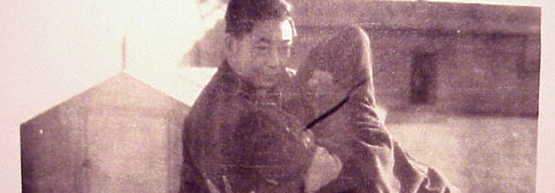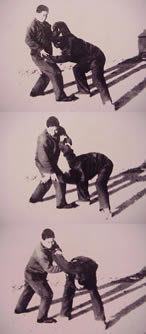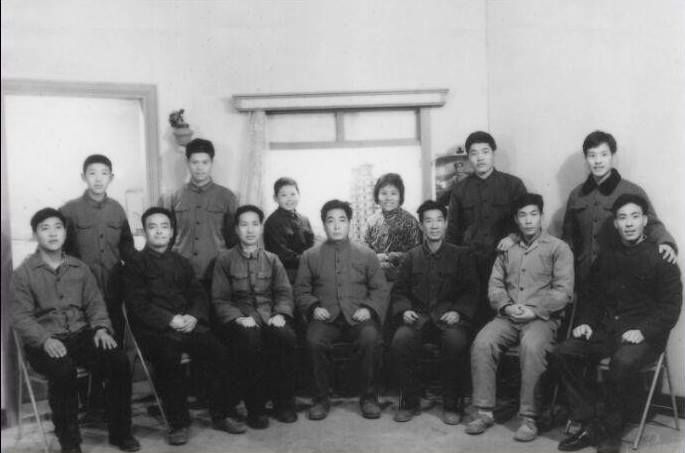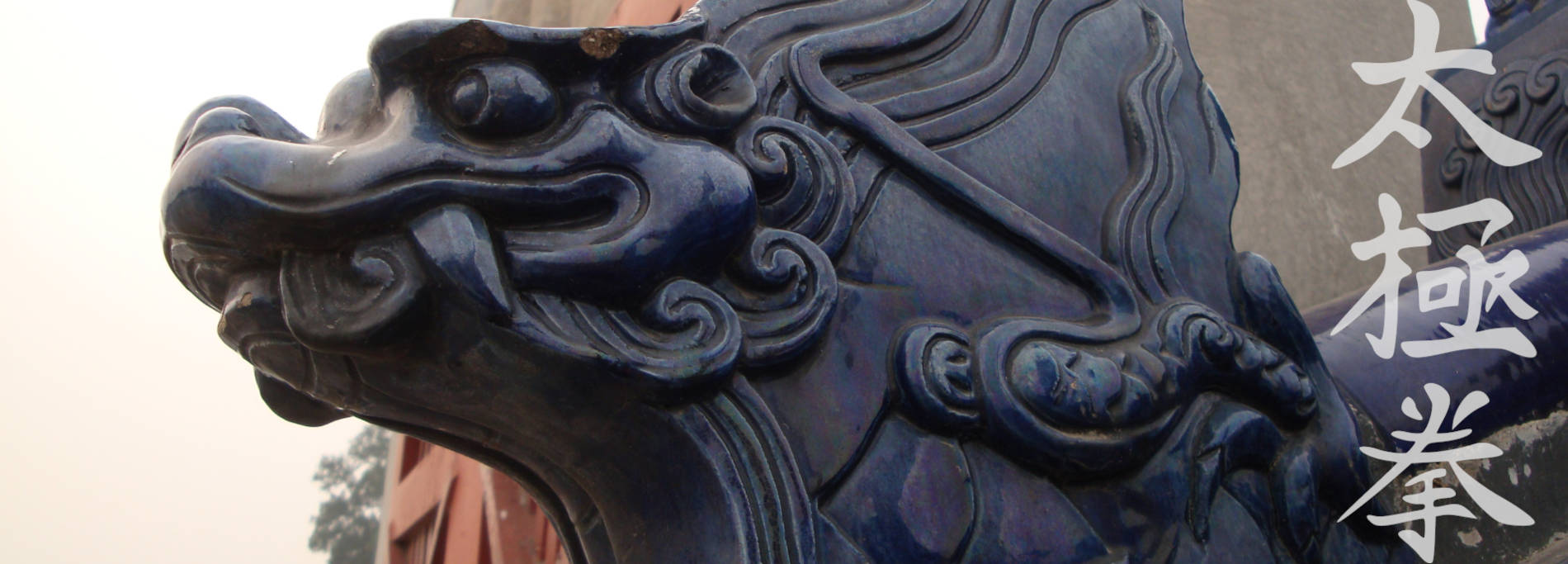I wrote this in 2011 as I thought there was so little information available on Chen Zhaokui. This is the English translation of the German text. I did not have the time to check all original translations again, so there are surely some parts which might be expressed in a much better way. But I wanted to share the article as I think it contains some elements not so often talked about. There is a biography of Chen Zhaokui which can be found here on the website. I made some smaller revisions here in the article while translating it. Let me know what you think!
The multifaceted teaching of Chen Zhaokui

Chen Zhaokui (Chinese 陈照奎, January 24th, 1928 - May 7th, 1981) is an outstanding representative of the 18th generation of the Chen family and the link between the famous Taijiquan of his father, Chen Fake, and the current generation of practioners. He began to learn Taijiquan from his father in Beijing at the age of 7 (as did his own son Chen Yu later). Chen Zhaokui himself revolutionized the teaching and used modern knowledge and terminology. In addition to his interest in classical literature and ancient Chinese military writings, he was also keen to use modern medical and anatomical knowledge (cf. Ma Hong, undated). He can thus be described as a mediator between tradition and modernity.
Taiji form training
His method emphasizes the martial benefits of Taijiquan and a detailed and challenging practice. In addition to the hand and weapon forms, Chen Zhaokui practiced extensively Tuishou (pushhands) and Sanshou (free fighting applications). But he always emphasized:
“Practicing the form is the most important basic exercise, because any form position is a summary of effective hitting/punching and grappling/wrestling methods. All martial arts initially contain individual techniques [at the time of their creation], and gradually combine more movements, which are then called 'forms' or 'boxing frames'. Thanks to the training of the form, all movements can be learned in such a way that they meet the requirements of fighting."
He added: “Chen-style Taijiquan is an advanced martial art because it has deep and broad content. There are no shortcuts, and even if you are smart, it will take you a long time to get it right. It takes several decades to understand it correctly and to fully grasp the gongfu. You can usually learn a form in six months, but to practice it correctly you will need several years of strenuous practice. Therefore one has to study every movement in every position, every hand and foot position, and pay attention to the basis correctly when learning the form. When you start to study, you cannot do it without strict requirements, and if you take it too lightly it leads to great difficulties [later]. If you start out and stick to the requirements strictly, and also work on the basics, then [the progress] looks slow at first, but later you will find it easier to go deeper and you will then progress faster. Some are greedy for rapid progress and want to understand Taijiquan in a short period of time, but that would not really be a great achievement. If people do not practice the form well, but only do some Tuishou (pushing hands) and only shove people away, then that's just ridiculous."
(Quoted from Ma Hong, 1998, p. 354).
He always preferred a very structured training: "According to general experience, when you learn a science or an art, you should have a clearly defined concept of what methods you should use and what steps you should take" (Chen Zhaokui and Chao Zhenmin, 2011, p. 55).
For Chen Zhaokui, the connection between form and applications training in Taijiquan was of decisive importance: “The form is the basis for the pushing hands, pushing hands is the test of the form, whether it is performed correctly. Pushing hands exercises therefore help to transition from form training to real combat training. If you only train the pushing hands and not the form, you can still learn how to counter an attack with techniques, but it is impossible to grasp the entire, correct, basic movements. It is then easy to get used to some wrong movements and it becomes difficult to make great progress”(quoted from Ma Hong, 1998, p. 355).
Chen Zhaokui summarized eight basic requirements in Chen Taijiquan for correct form training as follows:
1. The upright posture is the most important requirement; it implies that the knees should be bend but not protruding above the toes, that the crotch area is rounded, the hip area sunk, the chest restrained, the upper body upright, the crown of the head as if suspended, the shoulders sunk, the elbows hanging, that qi is sunk, the five fingers lightly gripping, the center is stable and maintained in all eight directions
2. The start, end and course of every movement must be clear
3. [correct] hand posture and method: the following (shun) and counter-rotating (ni) silk reeling of the arms and the change of direction of the movements is clear
4. [correct] stepping types and methods: especially the silk reeling in the legs and feet and how to move up and down is clear
5. Opening and closing of the chest and waist: rotational directions of the chest and waist, angles and alternation of opening and closing
6. turning the center: involves moving the crotch area around the back in an arc and weighting the center to the left or right [...] and tilting and lowering the buttocks following the center
7. the [correct] focus and direction of the gaze and expression in the eyes
8. the coordination of breathing with the boxing positions
(in Ma Hong, 1998, p. 356)
Yang Wenhu remembers training with Chen Zhaokui
When Chen Zhaokui returned to Beijing from Shanghai after the start of the Cultural Revolution in 1966, he no longer had a job. Tian Xiuchen (a well-known student of Chen Fake) helped with his 20-30 students to secure the income of Chen Zhaokui. He needed 60-70 yuan (RMB) for a living per month. His mother still lived in his household, as did his son Chen Yu. Chen Zhaokui pointed out that the boxing method he taught had never been taught outside the family line since Chen Changxing. Many methods of developing skill and many small movements and force pathways were taught within the form.
Only after three years of the middle basin (zhong pan), i.e. training in medium-high stance, did he also teach the lower level (di pan). He said the middle one mainly works the muscles, tendons and skin, while the deep one works the bones. The latter, however, was very exhausting and almost unbearable. In addition, Chen Zhaokui taught joint locking methods (qinna), throws (shuaijiao) and free fighting applications (sanshou) (Yang Wenhu, 2009, p. 146).
Chen Yu: early personal memories
"My father and I supported each other and were dependent on each other. After I started practicing Taijiquan with father, my body gradually got stronger. Taijiquan gave me a second life. After my grandmother died [1972, editor's note] and in spite of my young age it was my job to look after my father. To take care of father, I visited my aunt Chen Yuxia and learned to cook from uncle. My aunt's house was not far from away from our house, on the other side of the street, so to speak. I washed the laundry for father. In winter, when the water was freezing, my little hands froze.
Father had a leather suitcase full of novels and books on Taijiquan. No matter where father went to teach, he always had this little suitcase with him. The last time I saw this suitcase was after my father died. But the suitcase was empty and all the books were gone. My father and I lived together for over ten years. Although we were poor, we had a spiritually rich life. Our main content and topics consisted of our family's training method. When I think back to our conversations, it was almost always about our training. After my father died, I retired for three years to train intensely (bitterly). He often supported me in dreams and guided my training." (Chen Yu, 2011, translated by Filip Gutknecht-Stöhr). This story is very moving to me. When we went to Beijing with students Chen Yu always said he wanted to cook for us and be our host. This sounded entertaining at the time, but with the story behind it and why he learned to do this, it feels very personal and moving to me.
The teaching method

One of today's representatives of the Chen style, Zhu Tiancai, said of his second teacher Chen Zhaokui: “The boxing form passed down by Chen Zhaokui involved extremely fine movements, a great number of hand methods, sudden fajin, and very clear boxing applications; so it trained a very comprehensive skill" (Wuhun, 1990/5, quoted here from Ma Hong, undated).
Chen Zhaokui always asked students, "Do you want to study in detail or do you want to learn quickly?" (Ma Hong, 1998, p. 361). His question was intended to make it clear that learning quickly would neglect many details, which can lead to problems later. That is why his methodology was so extremely accurate. For example, when he was teaching in Zhengzhou (the capital of Henan Province, author's note) from 7-10 o'clock in the evening, he only showed a single boxing position during those three hours, but this was broken down into many individual movements. In the first hour of training he just demonstrated and explained the movement and no student participated. Everyone should first understand the movement and get an overall impression of it and, if necessary, take notes. In the second hour the movement was rehearsed and repeated together. In the third lesson, each individual student was corrected individually and in much detail. Each movement was broken down again into individual movements and all requirements, positions and directions were discussed in detail, e.g. with regard to the rotation of the chest and waist, the change of the center of gravity, the positioning of legs, knees and upper body and the following and counter-rotating silk reeling methods, the sequence of steps and the hand shapes. Eye movements, listening, inhalation and exhalation, and the internal force of every movement were detailed and precisely executed. Chen Zhaokui was considered to be very strict with his students during training. Zhang Maozhen reports that when the pathways of internal force (jinlu) were unclear, Chen Zhaokui asked that the movement be repeated 500 times. Chen Zhaokui's son, Chen Yu, also often talks about how hard he had to train under the guidance of his father. But Chen Zhaokui also trained very hard and didn't spare himself.
In Beijing he once said to his student Ma Hong that one must be both light and sunk, must have empty and full, must open and close, change between fast and slow, and all elements togehter must be winding in relation to one another. He demonstrated this and emphasized: “Opening, but not as if you were tearing something apart, but opening in a spiral, as in 'covering with your hand and hitting with your upper arm' (yan shou gong chui) the first movement; fast, but not simply fast without a break, but a spiraling speed, as in 'successive fire' (lian zhu pao); sunk, but also a spiral sinking, as in 'lazily tying coat' (lan zha yi) the last movement ... ” (Ma Hong, undated).
Chen Zhaokui explained why he paid so much attention to the correct postures: "When you mould the frame, you have to build up the respective position in a correct way. Because the small and large joints must all be opened and the shoulder axis must be drawn out, if only one of these places is not opened up, the internal energy (neiqi) cannot penetrate" (according to Chen Yu, 2011).
He subdivided the movement sequence of 'Buddha's warrior attendant pounds mortar' alone into 25 different types of force (jin). "Parting the wild horse's mane" (ye ma fen zong) he described thus:
“First the left hand drills downwards, then it supports upwards, then with the heel of the hand it presses to the left outside; at the same time you open the right side of the chest and perform a shoulder thrust, stretch your right hand downwards and press the heel of your hand down to the right; this is a left bow step, the left foot must exert holding force, the right foot directs the force, and dantian must always be the pivot; the right foot turns the force together with the left hand, which drills with force, supports and pushes up with the ball of the hand, so that all parts are connected with one another like a chain, a chain of alternating forces. Little by little internal strength is being developed and everything is connected harmoniously."
(after Ma Hong, undated)1.
From this careful, structured way of training, coherent skills are being formed, described such as "the intention is uninterrupted", "the body (method) is uninterrupted", "the force (jin) is uninterrupted", "the expression of the mind in the eyes (shen) is uninterrupted "," the peng force is uninterrupted "," the closing force is uninterrupted "and" the opening force is uninterrupted "(cf. Chen Zhaokui, 2005). According to memories of his students, Chen Zhaokui emphasized that the Taiji movements should always be "fast but not chaotic, slow but not interrupted, sunk but not stiff, and light but not fluttering" (from the Chinese after Zhang Qilin, 2008). Feng Zhiqiang told me that Chen Zhaokui himself did his forms in a very low stance, in order to strengthen the leg strength. Because he emphasized the importance of the body base in terms of leg and footwork. He said: "If the soles of the feet are not correct, then the upper body is also incorrect" (Ma Hong, undated).

Folding of chest and waist
In Chen Zhaokui's method, the “folding of the chest and waist” (xiongyao zhedie) is of great importance: "In boxing, a thousand words cannot fully describe its miracles. But two characters are sufficient to summarize them: opening and closing. If you reach a certain level, you will understand that [...]. The most important thing for this is the folding of the chest and waist ". He often compared this to the movements of a silkworm or a snake, which transmit power from one limb to the next so that all parts are connected. Here it is important that you use the center of the body as the main axis for your movements: “In the movements of the chest and waist there is an opening, a closing, a bending, a stretching, a left, a right, a lifting up, a releasing , and the following and opposite changes. In the old theory it is said: 'There are foldings in going back and forth' ”(according to Ma Hong). But despite the folding, it is necessary to make sure that you stay upright, do not tilt your head and, above all, do not wobble, but still allow stretching and bending. "During any movement and also in silence, one must keep the qi sunk in the dantian the entire time, the tailbone is upright, and the center of gravity is kept stable, the body can rotate and is alive" (Chen Zhaokui and Chao Zhenmin, 2011, p . 57), because this is the only way to change your own point of force under the influence of external force even at high speed (ibid.).
Big frame, small frame, new frame of Chen Taijiquan
After Chen Zhaopi's death in 1972, Chen Zhaokui was invited to Chenjiagou to teach the younger generation, and the villagers called his style "xinjia", the "new frame" because it was unknown to them. This frame is still taught there today, but its internal methodology according to Chen Fake and Chen Zhaokui has been largely forgotten in the village.
Chen Peishan, a famous small frame practioner of Chen Taijiquan, remembers: "As far as I can remember, new frame (xinjia) was first mentioned in Chenjiagou around 1976. During this time, Chen Zhaokui, the son of Chen Fake, returned from Beijing to Chenjiagou Village to teach Taijiquan. Back then, students who were willing to learn gathered in the village square in the morning to learn from Chen Zhaokui. He often stood on a pedestal that was specially set up so that one could see him better during his Taijiquan performances. In the evenings he taught a small group of selected students. These were in the favor of learning the form (taolu) with many details and fajin movements. During the Cultural Revolution, Taijiquan could only be practiced in secret. Many masters left the village to live elsewhere, underground. There has been abduction, detention and many bad things during that time. Chen Zhaokui's demonstrations differed from the forms that were then practiced on a large scale in the village. This probably led some villagers to the assumption that this must be something new or a new form (xinjia). During this time I was visiting relatives in Chejiagou. Chen Zhaokui was a guest at my uncle Chen Lizhou's house, where Chen Yu, Chen Zhaokui's son, and I stayed together a lot. As I said, as far as I know, no one had spoken about a new or old frame in the village before that time. The terms large and small frames were quite common." He then says: "Even today, the question of why the form of Chen Zhaokui is called xinjia is not entirely clear. In the meantime it has simply become common to use this term. It is also controversial whether the so-called xinjia was compiled as a form of Chen Fake or whether it is even of older origin. To the outsider, the whole thing must appear very confusing. My father told me that the so-called xinjia represents a gongfujia - a higher level - in big frame (dajia)."
Chen Zhaokui categorically refused to use the term "new frame". In one manuscript he wrote together with Chao Zhenmin (a student of Chen Fake), he calls the form he practices 'Chen style taijiquan old frame' 陈式太极拳老架. In Shijiazhuang, capital of Hebei Province, he said in 1979: “That expression [xinjia] is wrong. My fifth brother, Chen Zhaopi, also learned boxing from my father [Chen Fake] in his day. These are all boxing forms that Chen Changxing already taught ”(based on Ma Hong, undated). For Chen Zhaokui, it was not the external frame, but the completion of the fighting technique through internal work that was the decisive element: “If you do not have gongfu, then all techniques are empty, and if the gongfu does not come out, all techniques remain useless. The most important thing is to develop gongfu and to express it."
Bibliography:
Chen Peishan (2005). Xiaojia, der kleine Rahmen des Chen-Stil Taijiquan. Cultura Martialis (05/2005).
Chen Yu (2011). Taiji Rensheng. Mingjia Shuhua Chubanshe.
Chen Zhaokui (2005). Explanation of the silk-winding power in Chen-Taijiquan. Available at www.CTND.de.
Chen Zhaokui and Chao Zhenmin (2011). Chenshi Taijiquan Duanlian Jingyan Tan. In: Chen Yu: Taiji Rensheng (pp. 55-76).
Ma Hong (undated). Yidai zongshi Chen Zhaokui de zhongda gongxian. Available: www.cctq.info/taiji05.htm.
Ma Hong (1998). Chenshi taijiquan quanfa quanli. Beijing: Beijing tiyu daxue chubanshe.
Yang Wenhu (2009). Wo gen Chen laoshi xue quan de jingli. In Chen Yu (2011), pp. 146-150. Taiji Rensheng. Mingjia Shuhua Chubanshe.
Zhang Maozhen (2004). Chenshi taijiquan jingyi. Beijijng: Renmin tiyu chubanshe.
Zhang Qilin (2008). Memories of boxing training with Master Chen Zhaokui. Beijing, Available: cytjw.cn.
Footnotes:
1 In Chinese these depict many techniques from Taijiquan that are not so clear in the English translation and without proper practice of this line. These techniques always represent very specific force pathways, applications and processes.

